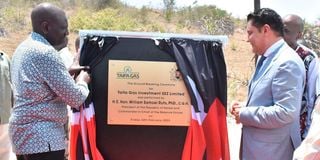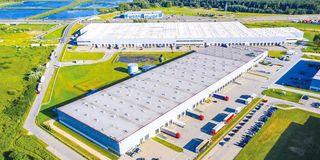Premium
A look at the five factors stifling the vision of the Special Economic Zones

President William Ruto and Taifa Gas Group Chairman Rostam Aziz unveil a plaque during the groundbreaking ceremony of the 30, 000 Metric Tons plant at the Dongo Kundu Special Economic Zone in Likoni, Mombasa County on February 24, 2023.
In the year 2015, Kenya enacted a law that would facilitate the creation of Special Economic Zones (SEZs), designated hubs whose purpose would be to drive economic growth and transformation of the country into a middle-income economy.
The SEZs would be classified based on the economic activity they focused on, and would include Agricultural Zones, Business Service Parks, Tourist and Recreational Zones, Free Trade Zones, Industrial Parks, and Science and Technology parks.
Regardless of how they were classified, certain similar privileges would be accorded to the SEZs to attract investors. For instance, land in these areas would be availed to developers at discounted rates.
Approval of permits for any construction works done here would be quicker than in other areas, and only one license would be required to operate in the SEZs. Developers of more than 100 low-cost residential units would be offered incentives such as 15 per cent corporate tax as opposed to the standard 30 per cent tax rate for developers operating outside the zones.
Businesses operating in the SEZs would also be exempt from a number of local taxes and would have access to more favourable energy tariffs.
All these incentives were expected to spur tremendous economic activity that would lead to the creation of several jobs within the SEZs. Many of the workers operating here would require decent housing within, or at least nearby the economic zones, therefore, it was also anticipated that the SEZs would significantly contribute to the growth of the construction sector, driving the development of more than half a million affordable housing units, and many more real estate developments within or near the SEZs.
There are currently 24 gazetted special economic zones in the country, 20 of these are privately owned, while four are owned by the government. Some of the state-owned SEZs include Konza Technopolis City, a science and technology hub which sits on 5,000 acres of land in Malili, Makueni County, Naivasha SEZ, which sits on 1,000 acres of land in Nakuru County, and Dongo Kundu SEZ, which occupies 3,000 acres in Mombasa County.
Some of the privately owned SEZs include Tatu City, the first operational mixed-use SEZ in the country, sitting on about 5,000 acres of land in Ruiru, Kiambu County. Others are SBM SEZ in Kwale County, Africa Economic Zone in Eldoret, Compact Free Trade Zone in Nairobi, Kipipiri SEZ in Nyandarua, Focus Free Trade Zone in Mombasa, Sleeping Warrior SEZ in Nakuru, and the Northlands in Kiambu.

In more advanced economies, such zones have been used by governments to lift citizens out of poverty. In China for instance, when the fishing village of Shenzhen was turned into an SEZ, it quickly transformed into a cosmopolitan city with a per capita GDP growth of more than 100 per cent, within a few years of operationalisation. With more than 20 gazetted special economic zones, Kenya could well be on the verge of achieving a similar feat, however, a number of factors continue to threaten the realisation of the SEZ dream in the country. Top on the list is poor politics.
Politics
While the National Government has been very supportive of the SEZ agenda, Alex Njage, the Head of Commercial Property at Bowmans Kenya, says that politicians at the county level have not necessarily bought into the vision.
These politicians play a key role in the establishment of SEZs within their area and have the capacity to exert influence on SEZ operations. Unfortunately, where it has benefited them, some of them have colluded with officials and contractors working in these zones, particularly those that are state-owned, for their own benefit. This interference has slowed their progress.
Recently, there were reports of interference in the Kenya Ports Authority (KPA) tendering process by influential third parties, which would result in the irregular awarding of major contracts for the development of the Dongo Kundu SEZ. Bidders and influential politicians had infiltrated the 11-member KPA tender committee in an attempt to influence the outcome of the tender in their favour.
“There is a need for county governments to be sensitised on the benefits of SEZs, to achieve a shared vision. We saw the current chairperson of the Council of Governors actively engaging governors and MCAs from all counties on this issue. There are also now policies being put in place to establish ‘county industrial and aggregation parks’ which are basically a permutation of special economic zones, these are positive strides,” notes Njage.

Bowmans Kenya Head of Commercial Property Alex Njage during an interview at ICEA Lion, Nairobi on June 7, 2023.
Though Kenya’s political landscape is relatively more stable than most other African states, the ongoing political headwinds being witnessed locally and within the wider EAC region have been dampening investor confidence, slowing the growth of SEZs.
Limited funding
Some of the state-owned SEZs have also faced challenges of limited funding, which has constrained their ability to set up the infrastructure needed to attract investors and developers. A case in point is the Naivasha Special Economic Zone, where work for the last two years has been brought to a near standstill due to a lack of adequate funds.
The government was to set up infrastructure such as roads and sewer treatment plants as well as ensure that there was constant water and power supply, but since this has not happened, many of the key investors who had shown interest in developing the SEZ have put on hold most of their development plans. The zone has also been reportedly facing challenges of vandalism and therefore requires additional funding to set up a permanent perimeter wall around the premises.
Land controversies
Special economic zones require huge tracts of land to set up. Since independence, land acquisition in Kenya has been a subject of intrigue and controversy, and these zones are no strangers to these controversies.
In 2021, former Kiambu governor William Kabogo was embroiled in a legal land tussle with Tatu City, in which the latter accused the former of illegally holding onto title deeds to blackmail them into giving up a stake in their project.

Perhaps one of the major factors that have stifled the growth of these economic hubs is the lack of clarity on the entire framework of SEZs. To many, the concept remains foreign.
“For such projects, there is always the risk of politicians who know that they will only be in office for a few years, attempting to make a quick buck instead of pursuing long-term development goals that could benefit their community,” notes Robert Omondi, an architect.
The architect claims that inefficiencies in the land registries have also been a major cause for concern, as they have contributed to an increase in the time taken to conduct due diligence or acquire land within the SEZs.
Omondi points out that in agricultural counties, the conversion of arable land into land being used to set up real estate developments for the SEZ workers has also threatened to affect the livelihood of communities that depend on agriculture.
The state has attempted to control construction activities in arable regions by limiting the amount of land allocated for SEZ development. The Africa Economic Zone in Eldoret for instance only covers 700 acres of land. The downside of this is that it has limited the level of investment going into these regions, even for value addition activities.
Unsustainable development
Setting up special economic zones is more complex than setting up municipalities, which can get away with unplanned developments. For SEZs, simply moving in to build without first setting up the necessary infrastructure is not an option.
“Issues such as sanitation, water availability, power supply, parks, good road networks, water treatment plants, sewage treatment plants and waste collection services, police and fire stations have to be addressed first,” says Douglas Logedi of the Green Heart of Kenya, a 750-acre sustainable development based in Kilifi.

Special economic zones require huge tracts of land to set up. Since independence, land acquisition in Kenya has been a subject of intrigue and controversy, and these zones are no strangers to these controversies.
The SEZs must also provide for appropriate medical facilities, training facilities, consistent internet and low-cost food facilities in the zones for use by the residents and workers. They also have to incorporate green architecture, sustainable designs, good transport networks such as rapid bus transit systems as well as innovative ways of recycling waste or reusing water for irrigation and fire systems.
"Developers have to be climate conscious. They have to be conscious of the environment and of the natural ecological systems. They have to try as much as possible to protect the flora and fauna of that space. That part of sustainable development is important," notes Logedi.
Failure to address these factors has resulted in disagreements between some SEZ owners and their developers, as well as buyers. For instance, late last year, Tatu City declined to approve plans that would see one of their developing partners, Home Bridge Limited, construct 652 houses on the land.
Tatu City claimed that the developer had breached a mutual agreement by not adhering to the correct building standards for developments that they had undertaken earlier. The complaints tabled by residents in the SEZ included poor internet connectivity, unsafe water and high power bills.
“Initially, the whole idea was that once the SEZs begin to operate successfully, then they can be used as models for existing municipalities to emulate. But if we start to hear complaints from residents, then perhaps the outcome will not be very desirable,” notes architect Omondi.
Lack of clarity/information on SEZs
Perhaps one of the major factors that have stifled the growth of these economic hubs is the lack of clarity on the entire framework of SEZs. To many, the concept remains foreign.
Gikonyo Gitonga, the Managing Director of Axis Real Estate, adds that the impact of SEZs has not been significant because most players have not appreciated or seen the benefits of developing in these zones.

If well implemented, SEZs will spur the development of Grade A buildings not only in the residential segment, but also in the commercial and industrial real estate segments and that we could see a lot of businesses moving their manufacturing sites from industrial area to the SEZs.
“The regulations for SEZs mainly favour industrial property developers and users. There is still a lot of uncertainty for developers of other property classes. Whilst the law anticipates a ‘one-stop-shop’ model for SEZ licensing and operations, SEZ developers and operators also still have to obtain a myriad of licenses from several licensing authorities before they can effectively implement their projects,” notes Mr Gitonga.
Despite these issues, however, Lachie Gordon, the managing director of the Green Heart of Kenya, says that Kenya’s favourable regulatory regime provides a unique opportunity for the rapid growth of SEZs.
"There is the ability to move quite fast here because approvals are done fast and the legislation works in favour of developers. In places such as Europe, it would take years to get approvals for projects of this scale," says Lachie.
Gordon adds that there is a bigger desire for people to move away from the major cities into the counties, and because many of these areas are under-developed, providing high-quality living in or near the SEZs is going to be an important part of the future. “Infrastructure development in these parts is happening fast, which provides an opportunity to build quite fast also. We have a number of SEZs coming up in Mombasa for instance, and with new roads being built into Kilifi, we can expect to see Kilifi as the new suburb of Mombasa,” notes Lachie.
Alex Njage agrees, adding that if well implemented, SEZs will spur the development of Grade A buildings not only in the residential segment, but also in the commercial and industrial real estate segments and that we could see a lot of businesses moving their manufacturing sites from industrial area to the SEZs.




